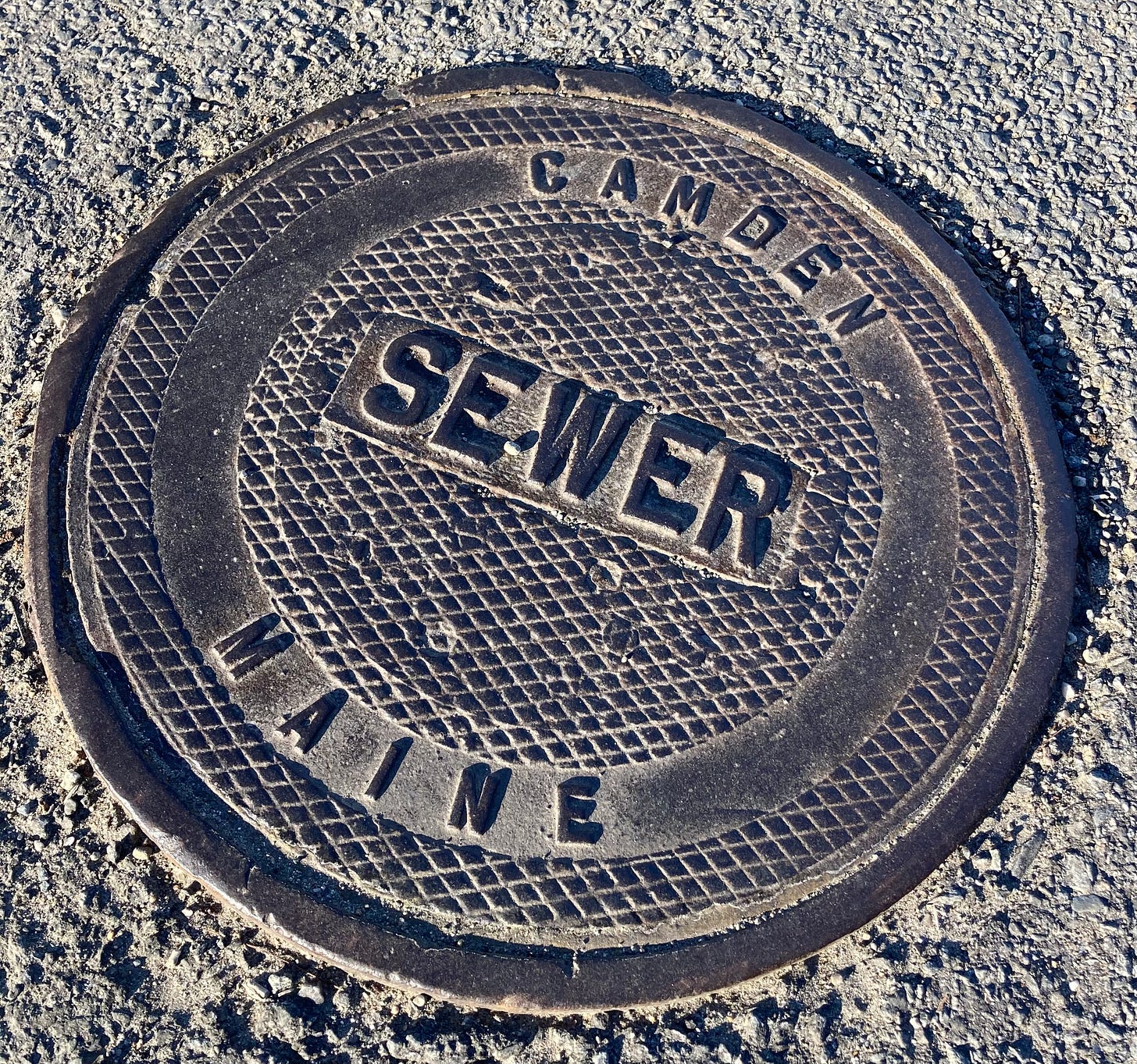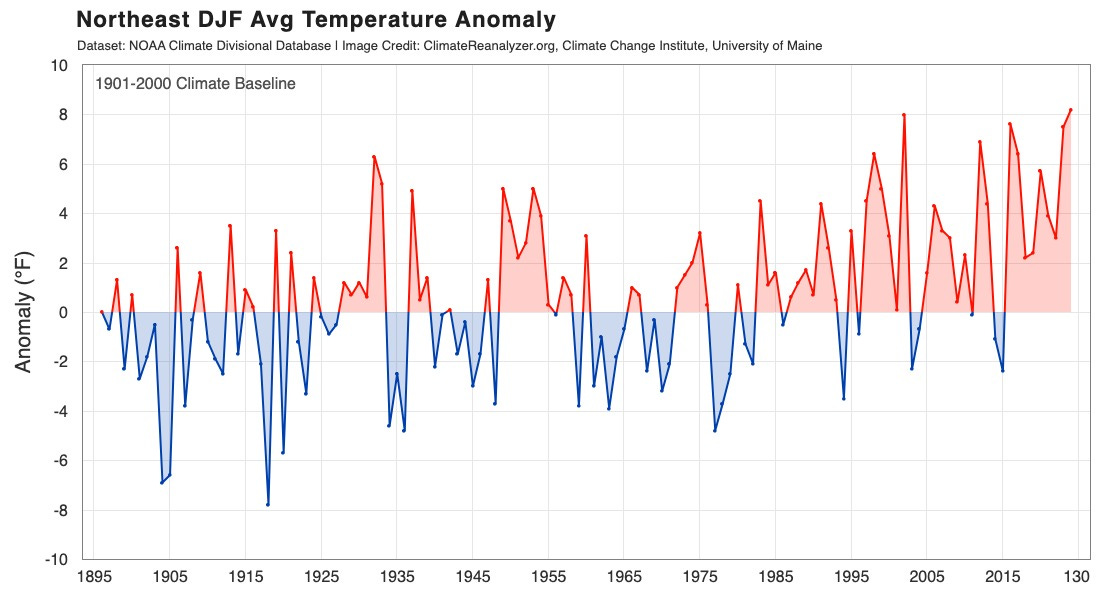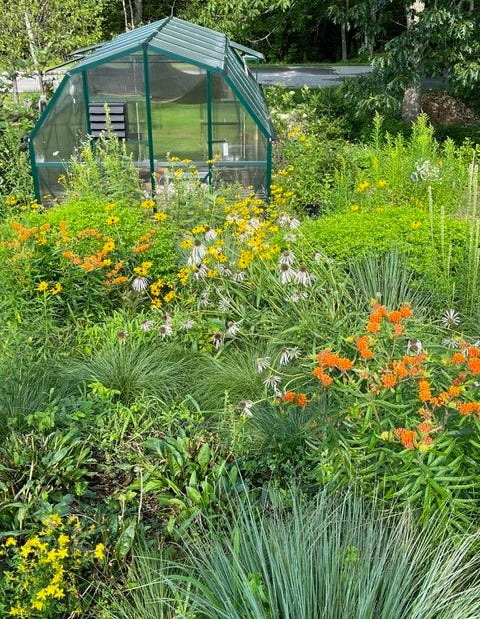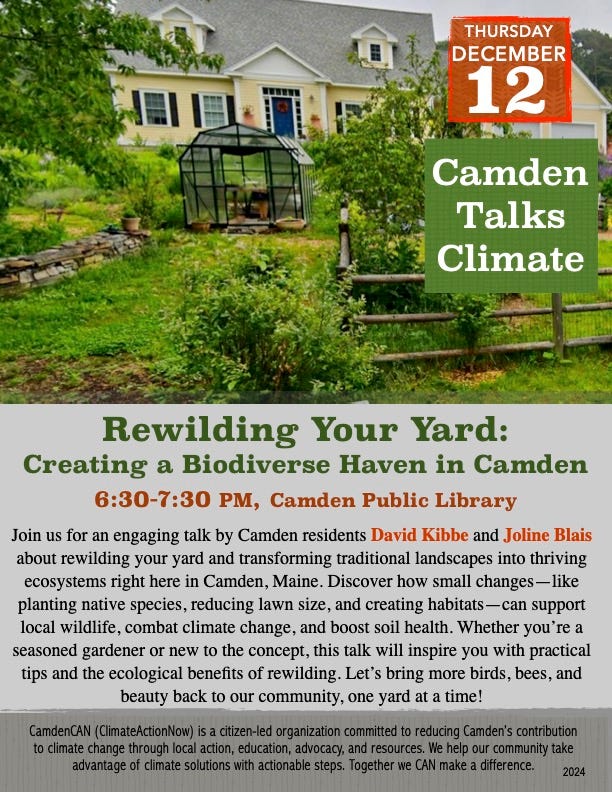What We Do Now Indicates Where We’ll Be In 2030
Dec 05, 2024

Recently we had a chance to look back at a report on the town’s work in 2020. We were both gladdened by the ambitious list, and saddened by the lack of progress toward Camden’s climate goals. We thought it might be worthwhile to use that 4-year-old-look-back to suggest what those actions—and our current (in)actions—mean for Camden’s possible future(s).
We don’t have a crystal ball, but the direction we’re heading now, in December 2024, pretty much indicates where we’ll be in 2030.
We’ve done some futuring here, with the hope that the stark reality of our climate (in)action might prompt more noisemaking and call for changes from you, dear readers, Camden’s citizenry.
Snow Bowl/Ragged Mountain Recreation Area—while the town has received a $160,000 grant (2024) to create a plan for a viable year-round facility, by 2030 the warming of Camden will leave us unable to make snow for a viably long ski season. Right now, we use a metric of 60-skier-days to assess the finances of a given season. By 2030 we’ll have debated and run the numbers for a 50-day season, and even tried a 40-day season; we suspect that below 40 days, running a ski area no longer makes economic sense. So we’ll be working in the next 5 years to let go of our ‘ski area’—finding other community uses for the recreation facility.

The accompanying graph of December, January, and February average temperatures (Northeast, USA) from the Climate Reanalyzer shows our warming trajectory. The warming won’t flatten out until we humans reduce our burning of fossil fuels. As discussed below, Camden is not reducing its burning of fossil fuels (and furthermore, making snow, as we are doing as I write this, burns fossil fuels, adding to the very warming causing us to say goodbye to snowmaking). By 2030 we may have agreed to build a new ‘lodge’ and we’ll be creating programs that make use of the erratic climate’s continued superstorms and wild temperature fluctuations.
- What can you do in 2025? Ask town officials about the connection between burning fossil fuels, snowmaking, and planetary warming: what’s being done to reduce our contributions to global warming? Also ask to clarify the maximum annual deficit (or maximum subsidy) we’ll give to the Snow Bowl to keep it open. Encourage policymakers to set that amount and stick to it. (Last operating season [‘23-’24] we subsidized the area with $340,000; the previous year it was $80,000; in 2016 the deficit was $297,000. Notice the correlation of those years with the red peaks on the graph above.)
Wastewater Plant/Stormwater I&I (Inundation and Infiltration) Issues—we’ll have kept picking away at the replacement of our aging storm and sewer lines (we approved a $20 million bond last June, as kind of an open-ended checkbook, to fund this), and we’ll also have voted to spend the nearly $40 million needed to upgrade the Wastewater Plant (this amount has not yet been budgeted or voted on). Because of this work, the super rainstorms that continue because of the warming planet are costing us less, since the storm water is going to the harbor, not the water treatment plant as it does now. Dialogues with Rockport will have paid off, and we’ll have structured a co-beneficial plan that adds portions of Rockport into our wastewater plant.
- What can you do? Urge town officials to continue their negotiations with Rockport so we have a bi-town wastewater agreement by 2030. Support the next bond that’ll be needed to rebuild Camden’s wastewater facility. And while you’re at it, encourage the town to add solar panels on the plant’s roofs to pay for the plant’s energy use—as Thomaston has done. Listen here.
Energy Independence in Municipal Accounts—Camden continues to spend over $325,000/year on electricity, struggling to get off its fossil-fuel addiction, despite a commitment to do so in 2020 (see section “Renewable Energy Development”). Recent 2024 and upcoming 2025 efforts to get more solar panels in town, and/or to do as Rockland has and become part of an offsite solar farm are getting slow traction. The only bright spot is the slight reduction in energy demand because of the termination of snowmaking at the Ragged Mountain by 2030.
- What can you do in 2025? Make noise, ask town officials why we can’t/won’t change course to energy independence.
Municipal Energy Use in Public Buildings—in 2020 we signed a contract with Siemens for improvements here (see “Performance Contracting for Town Buildings”). In 2025 we hope to have evidence of these improvements. (“The purpose of a performance contract is to increase energy efficiency, while guaranteeing energy savings are enough to cover the costs of the project.”) In our crystal ball of 2030 we hope we’ll have held Siemens fully accountable for energy savings.
- What can you do in 2025? Ask town officials for a public report on the energy savings attributed to this Siemens contract. If we didn’t reduce our energy needs, let’s make them do it again and get it right.
Town Planning/Stretch Codes/Height Accommodations—as the Harbor Resilience Planning wrapped up early in 2025, it became obvious that commercial and other structures in the harbor would have to build higher—3 feet, at least—to get out of the rising seas’s way. Over the course of 2025 and 2026 the town was able to rewrite and pass amended shoreland zoning rules to allow businesses to build 3 feet higher in these areas. This has helped these facilities withstand the continued storms, and get insurance not previously available. In addition, the forward-thinking planning board has followed the guidance of the Maine Climate Council and adopted stretch building codes, ensuring that new structures in town are energy smart, not adding to the warming planet.
- What can you do in 2025? Stay informed about the important climate work of the Planning Department.
Public Landing/Yacht Club/Harbor Park/Harbor Resilience—late in our 5-year scenario (let’s say 2029) the town was awarded a multimillion dollar grant to rebuild the public landing, moving the harbormaster’s office back toward the Chamber offices. In a forward thinking way, the wastewater pumping station and restrooms have also been moved west, and elevated. The public landing area is now covered with a permeable surface material that easily absorbs salt- and freshwater during flood events. There are also several ebike- and EV-sharing and plug-in facilities. And lots of greenery. Parking needs are handled by offsite facilities with solar panel rooftops—the automobile is no longer the center of our town planning.
By 2030 the Camden Public Library has reworked Harbor Park to accommodate the monthly king tides—and the resilient, natural environment solutions they’ve built for that purpose are the envy of towns along the northeastern seaboard. The private members of the Camden Yacht Club have also raised their clubhouse, providing their own funds and working with townspeople to ensure public access. Steamboat Landing, rebuilt in spring 2025, has suffered fewer major storms, but more adaptation building would be helpful.
- What can you do in 2025? Listen to the Harbor Resilience Planning sessions and attend the January 2025 final solutions gathering (date tbd) to stay informed.
Watershed/Dams—back in 2020 we had just been informed of the grant from Fish and Wildlife (see section “Megunticook River Restoration”). By June of 2025, the town will have voted for a hybrid solution for Montgomery Dam, yet by 2030 we won’t have received funding to rebuild. By 2028 and 2029, we’ve researched and found funds to help rebuild our high-hazard dams, and we’ve done a better job of sharing and practicing emergency flood scenarios so everyone along the river knows what to do in a 10-inch rainstorm.
- What can you do? Stay engaged in the river advisory committee’s work and lookout for upcoming outreach on emergency planning.
Emergency Planning/Drills—we’ll all become familiar with the plans and protocols necessary when floods/fires/storm surges are predicted. We’ll have created a warning system via technology and neighborhood associations. We’ll have a warming and cooling center open to all. We’ll know what to do in an emergency, and we’ll continue to improve these systems.
- What can you do? Watch this space as we hold public education and outreach events on climate-related emergencies and disasters.
Town Fiscal Health—taxes will have risen again, we’ll be skating by fiscally to meet the rising costs caused by the warming climate and reduced federal help, while repeated events eat away at our town and private reserves.
- What can you do? Start practicing fiscal restraint at home, and asking our town officials to do the same. Urge that the budget process encourage fewer needs, or more sharing with other municipalities, especially regarding emergency services. Say no to brand-new fossil-fuel vehicles.
Quality of Life/Citizenry/Community Vitality and Spirit—with the help of a 2025 Efficiency Camden (a potential co-project of CamdenCAN and the towns of Camden and Rockport), by 2030 more than 200 homes in the midcoast have received free energy coaching and subsequent home weatherization assistance. Discounted joint heat-pump purchases have been orchestrated, too, ensuring that hundreds of locals are saving money on heating, moving to non-fossil fuel energy.
In addition, by 2030, 25 households created pollinator and food gardens in areas traditionally reserved for “lawn.”
By 2029 neighborhood associations are holding regular potlucks; downtown Camden is closed to vehicle traffic once a month for seaside stroll events, and the annual town meeting has been revitalized, held annually in June, with a town-wide potluck.
- What can you do? Attend our 12/12/24, Camden Talks Climate: “Rewilding Your Yard: Creating a Biodiverse Haven in Camden” with David Kibbe and Joline Blais (see below). Also volunteer to be on or work with CamdenCAN’s steering committee (email us!).
Upcoming Climate Events and Activities
12/5/2024, Thursday, 5-7 pm, American Flatbread, in Rockport, Midcoast Climate, Energy, and Green Building Happy Hour. We’ll be in the upstairs room and look forward to a round of (your) community updates and announcements. All are welcome to this local group of folks who work, or are interested, in climate, clean energy, green building, and related topics.
12/7/2024, Saturday, 6-8 pm, Community Spirit Award Event—community potluck and celebration at the Camden Snow Bowl to celebrate an award from the Maine Ski and Snow Museum. See more at the town calendar, here.
12/11/2024, Wednesday, 4 pm, Friend Memorial Library, Brooklin, Maine, live or zoom. Presented by the Brooklin Climate Response Committee, “Loving in the North Woods: 25 Years of Historic Conservation in Maine,” by Karin Tilberg. Find out more here.
12/12/2024, Thursday, 6:30 pm, Camden Public Library, live or zoom. Camden Talks Climate: “Rewilding Your Yard: Creating a Biodiverse Haven in Camden.” Join us for engaging talk by Camden residents David Kibbe and Joline Blais about rewilding your yard and transforming traditional landscapes into thriving ecosystems right here in Camden, Maine. Discover how small changes in your yard—like planting native species, reducing lawn size, and creating habitats—can support wildlife, combat climate change, and boost soil health. Whether you’re a seasoned gardener or new to the concept, this talk will inspire you with practical tips and the ecological benefits of rewilding. Let’s bring more birds, bees, and beauty back to our community, one yard at a time! Click here for more, or to register via zoom.

Second and Fourth Tuesdays, 5-6 pm, starting January 2025, Camden Public Library, CamdenCAN book discussion group. Details to follow.
1/9/25, 6-7:30, via zoom (six Thursdays, ends 2/9/25), Become a Climate Ambassador. A Climate to Thrive, one of the leading grassroots climate action groups in the state, teaches a class in becoming a Climate Ambassador. See more details here. It’s well worth the time investment. If you sign up we’d love to hear about your experience and spread the word here, so let us know!
Concluding Thoughts
Camden 2030 may seem like a long way off, yet five years is a blink of an eye (it’s only 260 Mondays, after all).
As you know from reading Maine Won’t Wait (climate action plan), the state—and we, its citizens—have some ambitious goals for the next five years.
The state’s 2030 goal for home weatherization is 35,000 homes. We’d like to have 200 done in Camden.
By 2030 renewable electricity use in Maine is desired at 80%. Can we get Camden to that goal, too?
Camden isn’t run by the folks we employ or vote for. It’s run by each and every one of us, engaging in the issues, voicing our opinions, collaborating on solutions.
We need to express our ideas about Camden’s direction, shaping Camden’s 2030.
What are your five-year goals for Camden?
We’ve outlined some of ours above:
- town-wide reduction in greenhouse gas emissions and increase in energy independence;
- unite on a harbor resilience plan that supports the changing environment and support grants to rebuild adaptively;
- continue to improve our wastewater plant and stormwater woes;
- craft a plan for the Ragged Mountain Recreation Area that doesn’t burn fossil fuels;
- support and promote community activities that rework homes, neighborhoods, and yards and all the beings that inhabit them as ecological wonders;
- embrace and practice emergency plans, communications, and drills.
Underlying these goals is a vision of a Camden that focuses on: 1) caring for each other; and, 2) caring for our biosphere, our planetary home.
This Camden 2030 vision is not economically centered—economic vitality isn’t sustainable if the above two criteria aren’t met first.
